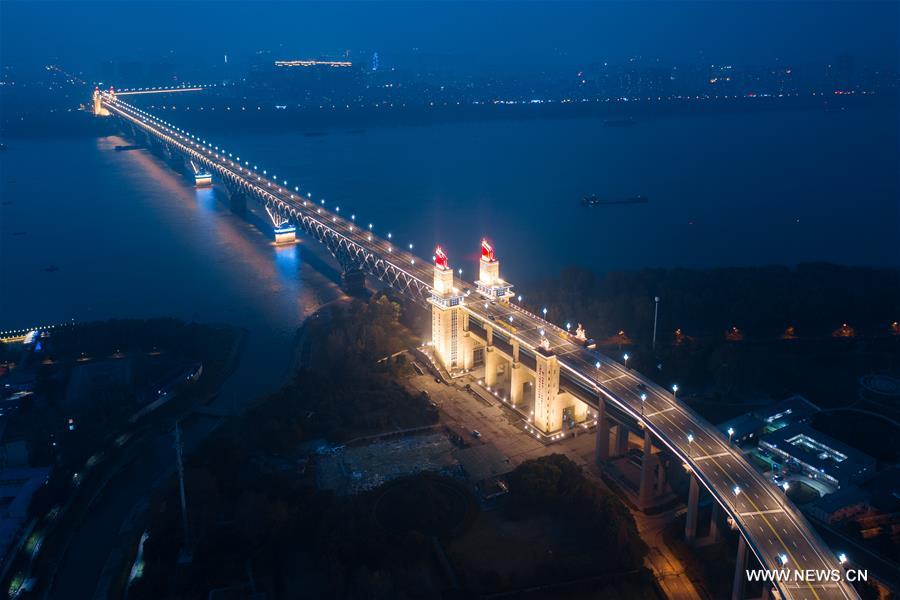


Aerial photo taken on Dec. 16. 2018 shows night view of Nanjing Yangtze River Bridge after renovation in Nanjing, east China's Jiangsu Province. (Xinhua/Su Yang)
Over the past 70 years since the founding of the People’s Republic of China (PRC), the Chinese people have given rise to numerous miracles by means of conquering technological difficulties.
From lagging behind other countries in transportation facilities, to owning the world’s longest high-speed railway mileage and expressway mileage, China’s road construction has achieved leapfrog development.
From independently designing and building the first super-large bridge-Nanjing Yangtze River Bridge, to constructing the world's longest cross-sea bridge-Hong Kong-Zhuhai-Macao Bridge, China’s bridge construction has become a name card of the country.
From lunar probing to underwater exploration, China has turned ambition into reality, creating a development miracle unseen in human history.
Why could China complete so many super engineering projects in only several decades? The achievements are inseparable from the leadership of the Communist Party of China and the advantages of the socialist system.
To build the Nanjing Yangtze River Bridge, the country spent 287 million yuan, while the gross output value of industry and agriculture in China back then was only 140 billion yuan.
Almost all bridge experts across the country were called together to design the bridge, and 7,000 to 10,000 builders were employed to construct the bridge from both the northern and southern banks of the Yangtze River.
Long Qipu, an engineer who took part in the construction of the bridge, recalled that they had conquered many difficulties including a lack of money, material, and technology, moving the project forward with full energy.
The reason why the country is able to undertake and finish major engineering projects is that it is able to concentrate all national efforts on big issues.
The south-to-north water diversion project, the largest of this kind in the world, is an example of how the country effectively executes plans with concerted efforts.
To guarantee that the project could proceed smoothly, about 380,000 people were relocated and 500,000 residents were re-employed, as the project goes through 100 counties in 7 provinces and cities.
The Party organizations and governments at all levels mobilized grassroots level cadres to communize with all impacted residents so as to make sure they were willing to be relocated.
The resettlement was completed within two years, a miracle in inhabitant relocation in the world, said a research fellow, who added that such efficiency is a valuable asset in the south-to-north water diversion project.
Innovation and craftsmanship have motivated China to build its own systems. What’s special about mega engineering projects? It’s not only just about the size and the capacity, but also about technological innovation and standards set by China.
China has seven of the world’s super-large ports in terms of the handling capacity. The Yangshan deep-water port in Shanghai is one of them. The 4th-phase port project, the world’s largest automated port, is equipped with 16 travelling cranes, 88 rail-mounted gantry cranes, and 80 automated guided vehicles.
The facilities empowered the port to finish loading and unloading of containers and horizontal transportation. It’s worth mentioning that all the systems for the phase-4 port were independently developed by Chinese enterprises.
These super projects, which manifest China’s accuracy, length, height and speed, cheer up the Chinese people and amaze the world.

 Award-winning photos show poverty reduction achievements in NE China's Jilin province
Award-winning photos show poverty reduction achievements in NE China's Jilin province People dance to greet advent of New Year in Ameiqituo Town, Guizhou
People dance to greet advent of New Year in Ameiqituo Town, Guizhou Fire brigade in Shanghai holds group wedding
Fire brigade in Shanghai holds group wedding Tourists enjoy ice sculptures in Datan Town, north China
Tourists enjoy ice sculptures in Datan Town, north China Sunset scenery of Dayan Pagoda in Xi'an
Sunset scenery of Dayan Pagoda in Xi'an Tourists have fun at scenic spot in Nanlong Town, NW China
Tourists have fun at scenic spot in Nanlong Town, NW China Harbin attracts tourists by making best use of ice in winter
Harbin attracts tourists by making best use of ice in winter In pics: FIS Alpine Ski Women's World Cup Slalom
In pics: FIS Alpine Ski Women's World Cup Slalom Black-necked cranes rest at reservoir in Lhunzhub County, Lhasa
Black-necked cranes rest at reservoir in Lhunzhub County, Lhasa China's FAST telescope will be available to foreign scientists in April
China's FAST telescope will be available to foreign scientists in April